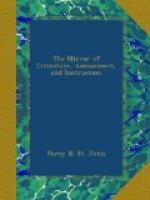Mr. Featherstonhaugh remarks, that the Natural Tunnel has not been worn through the rock by the long-continued action of running water is evident, not from the cavernous structure alone of the general country, but from the form of Powell’s mountain, in a spur of which the Tunnel passes transversely.
Mr. Featherstonhaugh further concludes the Tunnel to be a natural cavity in the rock, for, if such had not been the case, “it is evident that the stream would have been deflected from its line; would have followed the base of the hill, and have turned the extreme point.”
Little is known of the geology of the country in which this Tunnel is situate, notwithstanding the popularity of the natural bridges of the State. The rock before us would appear to belong to that class which geologists commonly term Perforated Mountains, which some suppose to have been bored through, in part, at least, by the persevering industry of man. “Such phenomena,” observes Maltebrun, “are, however, mere eccentricities of nature, and differ from caverns only from the circumstance of having a passage entirely through them. The Pierre-Pertuise in Mount Jura, and Pausilippo, near Naples, are instances of this kind. The Torghat, in, Norway, is pierced by an opening 150 feet high, and 3,000 long. At certain seasons of the year, the sun can be seen darting its rays from one extremity to the other of this vault. Near New Zealand is a rocky arch through which the waves of the sea pass at high water."[4] The latter, one of the Piercy Islands, will be found engraved and described in The Mirror, vol. xix. p. 145.
[1] See the Cut.
[2] This designation has been
given to a spot in the Valley of the
creek,
where formerly stood a hollow sycamore (platanus
occidentalis)
tree of an enormous size, the remains of which
are
still to be seen, and in the cavity of which, whilst
it
stood,
fifteen persons are said to have encamped at the same
time
together.
[3] Out-liers of any particular ridge.
[4] Physical Geography, book viii.
* * * * *
THE LATE SIR WALTER SCOTT.
(From the Note Book of a Tourist.)
In the summer of 1829, I made a Tour of the Borders. On the 16th of August, I arrived in Melrose. I came on the top of the coach from Jedburgh, in company with two intelligent fellows, a young Englishman of fortune (apparently,) and a Russian nobleman. We put up at the George, where we found about five tourists, redolent of sketch and note books, drinking toddy and lying in wait to catch a sight of the lion of the neighbourhood, Sir Walter. The voracity with which they devoured any anecdotes of him was amusing. In the evening it came on a peppering storm. I had foreseen this on our route from Jeddart. The Eildons had mounted their misty cap, always a




